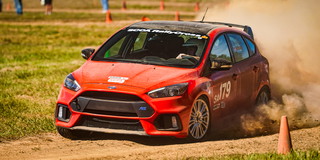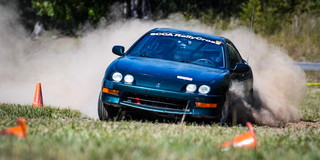
Low grip surface, dirt rooster tails, slipping and sliding action: What’s not to love about SCCA® RallyCross®? Described by some as “autocross in the dirt” (which isn’t accurate, although it offers a solid foundation to give you the gist of the sport), this single car timed trip around a coned unpaved course will leave your car covered in dirt while planting a massive smile on your face.
RallyCross events are generally held in large open fields with the course delineated by orange cones (similar to autocross). Because there are no physical obstacles (think: trees), RallyCross is an extremely accessible sport for anyone with a car (your daily driver will suffice), a Snell rated helmet (generally speaking, both M and SA rated helmets will work, although you should read the rules), and (generally speaking...once again, check the rules) a state-issued driver’s license.
Drivers get multiple runs around the course (again, similar to autocross), but unlike autocross, every single RallyCross run counts toward your final time. All your run times are then added together, and that determines your place in the results.
We previously covered the five things drivers need in the paddock at an autocross, and all of those items definitely apply to RallyCross as well. But because RallyCross is played in the dirt, there are four other items you’ll need to make your dirty weekend a bit cleaner.
1. Second pair of shoes
RallyCross events are held in dirt or gravel lots with cars driving in said dirt or gravel – the result is dust. To combat the pesky dust, at some events, a water truck is deployed to dampen things down. Here comes some science: Dirt plus water equals mud.
If it’s a damp or rainy weekend, you’ll also have mud. And while mud is super fun to slide a car around in, it’s not as much fun to walk in.
Like autocross events, competitors get an opportunity to walk the course before an event (which means your shoes will be covered in dirt and possibly mud). Also, like autocross, participants will work the course to pick up cones that get unintentionally knocked over by a vehicle. Working the course means tromping through dirt and mud.
Here’s where the second pair of shoes comes in clutch: When it’s your turn to drive the course, the last thing you want on the bottom of your feet is mud or dirt. Sure, you want your car to slip and slide on course, but you don’t want your feet slipping and sliding on the brake and gas pedals. Solution: Bring a second pair of shoes, swap on the clean set before you’re about to drive, then go fast and don’t hit any cones.
You’re welcome.
2. Dust mask and glasses
Dust, it’s a four-letter word; it’s also a RallyCross reality.
Back in the day, I’ve seen people use bandanas and goggles to keep the dust out of their eyes and lungs. Then in 2020, the pandemic hit the planet making masks readily available everywhere. Now, having a mask handy for a RallyCross event is as easy as stopping at 7-11 to grab some bottled water and snacks before heading to an event. Bring a few masks and keep your lungs clean.

(Keeping dirt out of your eyes and lungs is easy. Photo by Rupert Berrington)
3. Large tarp
Competing in the dirt usually also means working on your car in the dirt.
Whether you’re changing wheels, fixing a part, or simply keeping an eye on components between runs, I can tell you from experience that crawling underneath a car in the dirt or mud is not awesome. To keep things tidy, just like professional rally teams, a large tarp on the ground held in place with some tent stakes (bring a hammer for the tent stakes) makes for a perfect (and clean) paddock space for tinkering on your ride. Tarps are inexpensive and fold up for travel to the next event. Easy.
4. Jack and jackstand boards
Because you’ll be working in the dirt or gravel (or even less fun, mud on a rainy weekend), using a jack to raise your car to change tires or check brakes and suspension components can be challenging, especially on uneven surfaces. A piece of wood under the jack is a simple solution to ensure your car will raise up in a safe and successful manner – then do the same for jack stands.

(Boards are a simple purchase that will keep you safe at the event. Photo by Rob Krider)
Having a jack sink deep into the mud doesn’t help anybody. A thick, capable wood board will ensure your jack and jack stands work as designed, with the board spreading the load to ensure maximum safety. Wood boards are also cheap to buy and easy to stow inside your car. Grab some.
About the author: Rob Krider is a national champion racer, the author of the novel Cadet Blues, and is the host of the Stories and Cocktails podcast.
Lead photo by Rob Krider










